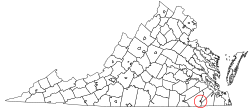Franklin, VA
| Franklin, Virginia | ||
|---|---|---|
| Independent city | ||

Downtown Franklin, Virginia (photographed by Taber Andrew Bain)
|
||
|
||
| Motto: "Growth – Community – Spirit" | ||
 Location in the Commonwealth of Virginia |
||
| Coordinates: 36°40′29″N 76°55′50″W / 36.67472°N 76.93056°W | ||
| Country | United States | |
| State | Virginia | |
| County | None (Independent city) | |
| Incorporated | March 1876 | |
| Government | ||
| • Mayor | Frank Rabil | |
| Area | ||
| • Total | 8.3 sq mi (21.6 km2) | |
| • Land | 8.2 sq mi (21.3 km2) | |
| • Water | 0.2 sq mi (0.4 km2) | |
| Elevation | 39 ft (12 m) | |
| Population (2010) | ||
| • Total | 8,582 | |
| • Density | 1,046/sq mi (403.8/km2) | |
| Time zone | EST (UTC-5) | |
| • Summer (DST) | EDT (UTC-4) | |
| ZIP code | 23851 | |
| Area code(s) | 757 | |
| FIPS code | 51-29600 | |
| GNIS feature ID | 1494943 | |
| Website | www |
|
Franklin is an independent city in the Commonwealth of Virginia. As of the 2010 census, the population was 8,582. The Bureau of Economic Analysis combines the city of Franklin with Southampton County for statistical purposes.
The city of Franklin had its beginnings in the 1830s as a railroad stop along the Blackwater River. During this era, the river was used to transport goods to and from Albemarle Sound in North Carolina.
In 1862, the Civil War came to Franklin, in what was referred to as the Joint Expedition against Franklin. As several U.S. Navy flag steamships, led by the USS Commodore Perry, tried to pass through Franklin on the Blackwater River, a band of local Confederates opened fire on the ships. As stated by an officer aboard one of the ships, "The fighting was the same—Here and there high banks with dense foliage, a narrow and very crooked stream, with frequent heavy firing of musketry."
In all, the battle yielded five naval casualties killed in action and 16 wounded. As the naval vessels retreated, the Confederates tried to block the narrow Blackwater River by felling large trees across it. In the end, the Confederate attempts failed, as no soldiers were captured and no ships were lost. A total of seven Medals of Honor were awarded to individual seamen for their distinguished service.
It was not until 1887 that Franklin began to see significant growth. Six brothers from the Camp family, with local roots, took possession of a local sawmill. The sawmill was small and had been operating for several years alongside the Blackwater River With the Camp family's acquisition of the mill, it experienced 20 years of rapid growth under the leadership of Paul Douglas Camp (president), James Leonidas Camp (vice-president) and Robert Judson Camp (secretary-treasurer). At the end of this period, after a bout with near-bankruptcy, World War I brought the Camp family back to financial success, bringing along with it the city of Franklin. By 1918, "Tiny Franklin had become a booming wartime village..."
...
Wikipedia

